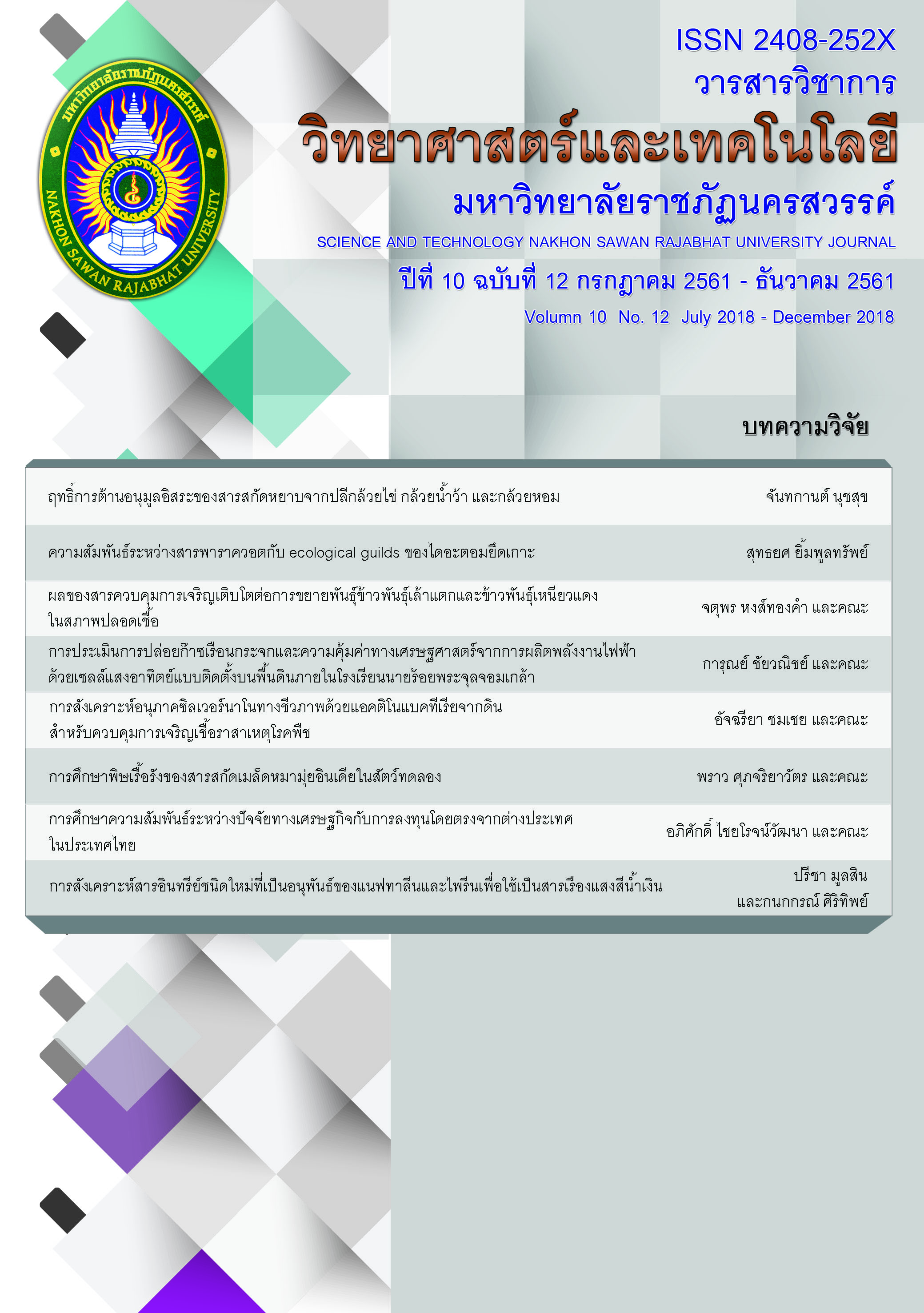การสังเคราะห์อนุภาคซิลเวอร์นาโนทางชีวภาพด้วยแอคติโนแบคทีเรียจากดินสำหรับควบคุมการเจริญเชื้อราสาเหตุโรคพืช
Main Article Content
Abstract
งานวิจัยนี้ได้ศึกษาแอคติโนแบคทีเรียที่แยกได้จากดินมาใช้สังเคราะห์อนุภาคซิลเวอร์นาโนทางชีวภาพด้วยน้ำเลี้ยงเซลล์กับสารละลายซิลเวอร์ไนเตรท (AgNO3) ความเข้มข้น 1 มิลลิโมลาร์ พบว่า 88.5% ของจำนวนตัวอย่างน้ำเลี้ยงเซลล์แอคติโนแบคทีเรียทั้งหมด 52 ตัวอย่างสามารถรีดิวซ์ให้เกิดการสังเคราะห์อนุภาคซิลเวอร์นาโนได้ โดยเปลี่ยนสีสารละลายเป็นสีเหลืองถึงสีเหลืองส้มเทียบกับชุดควบคุม เมื่อทดสอบฤทธิ์การยับยั้งการเจริญของเส้นใยราสาเหตุโรคพืชจำนวน 4 สายพันธุ์ ได้แก่ Colletotrichum sp. Fusarium sp. Pyricularia sp. และ Alternaria sp. พบว่า อนุภาคซิลเวอร์นาโนทางชีวภาพของแอคติโนแบคทีเรีย DSK-3 สามารถยับยั้งการเจริญของเชื้อราได้มากกว่า 30% จำนวน 3 สายพันธุ์ คือ Alternaria sp. (36.6%) Colletotrichum sp. (32.4%) และ Fusarium sp. (31.7%) เมื่อศึกษาความเข้มข้นของอนุภาคซิลเวอร์นาโนทางชีวภาพของแอคติโนแบคทีเรีย DSK-3 พบว่า ระดับความเข้มข้น 500 ไมโครกรัมต่อมิลลิลิตร สามารถยับยั้งการเจริญของเชื้อราทดสอบได้ทั้งหมดและมีค่าการยับยั้งมากกว่า 50% อนุภาคซิลเวอร์นาโนทางชีวภาพมีลักษณะเป็นลูกบาศก์ขนาด 100-200 นาโนเมตร และมีปริมาณธาตุองค์ประกอบของซิลเวอร์สูงถึง 64.4% จากการวิเคราะห์ด้วยกล้องจุลทรรศ์อิเล็กตรอนแบบส่องกราดและเทคนิคเอกซเรย์สเปคโตรสโคปแบบกระจายพลังงาน เมื่อเปรียบเทียบลำดับเบสบริเวณ 16S rRNA ของแอคติโนแบคทีเรียกับข้อมูลใน GenBank สามารถบ่งชี้ได้ว่า แอคติโนแบคทีเรียไอโซเลท DSK-3 จัดอยู่ในสกุล Streptomyces โดยมีความใกล้ชิดกับ Streptomyces coelicoflavas (NBRC 15399) ที่ความเชื่อมั่น 98%
Article Details
References
Ali, S.M., Yousef, N.M.H. & Nafady, N.A. (2015). Application of biosynthesized silver nanoparticles for the control of land snail Eobania vermiculata and some plant pathogenic fungi. Journal of Nanomaterials, 3, 1-10.
Boxi, S.S., Mukherjee, K. & Paria, S. (2016). Ag doped hollow TiO2 nanoparticles as an effective green fungicide against Fusarium solani and Venturia inaequalis phytopathogens. Nanotechnology, 27 (3), 42-51.
Buszewski, B., Railean-Plugaru, V., Pomastowski, P., Rafinska, K., Szultka-Mlynska, M., Golinska, P., Wypij, M., Laskowski, D. & Dahm, H. (2018). Antimicrobial activity of biosilvernanoparticles produced by a novel Streptacidiphilus durhamensis strain. Journal of Microbiology, Immunology and Infection, 51, 45-54.
Chaudhary, H.S., Yadav, J., Shrivastava, A.R., Singh, S., Singh, A.K. & Gopalan, N. (2013). Antibacterial activity of actinomycetes isolated from different soil samples of Sheopur (A city of central India). Journal of Advanced Pharmaceutical Technology and Research, 4(2), 118–123.
Elamawi, R.M., Al-Harbi, R.E. & Hendi, A.A. (2018). Biosynthesis and characterization of silver nanoparticles using Trichoderma longibrachiatum and their effect on phytopathogenic fungi. Egyptian journal of biological pest control, 28 (28), 1-11.
Farris, M.H. & Oslon, J.B. (2007). Detection of actinobacteria cultivated from environmental samples reveals bias in universal primer. Letters in Applied Microbiology, 45, 376-381.
Ge, L., Li, Q., Wang, M., Ouyang, J., Li, X. & Xing, M.M.Q. (2014). Nanosilver particles in medical applications: synthesis, performance, and toxicity. International Journal of Nanomedicine, 9, 2399-2407.
Kim, S.W., Jung, J.H., Lamsal, K., Kim, Y.S., Min, J.S. & Lee, Y.S. (2012). Antifungal effects of silver nanoparticles (AgNPs) against various plant pathogenic fungi. Mycobiology, 40 (1), 53-58.
Krishnakumar, S. & Bai, V.D.M. (2015). Extracellular biosynthesis of silver nanoparticles using terrestrial Streptomyces sp-SBU3 and its antimicrobial efficiency against plant pathogens. International Journal of Technochem Research, 1 (2), 112-118.
Li, X., Xu, H., Chen, Z. & Chen, G. (2011). Biosynthesis of nanoparticles by microorganisms and their applications. Journal of Nanomaterials, 8, 1-15.
Mahdizadeh, V., Safaie, N. & Khelghatibana, F. (2015). Evaluation of antifungal activity of silver nanoparticles against some phytopathogenic fungi and Trichoderma harzianum. Journal of Crop Production, 4 (3), 291-300.
Manivasagan, P., Venkatesan, J., Sivakumar, K. & Kim, S. (2016). Actinobacteria mediated synthesis of nanoparticles and their biological properties: A review. Critical Reviews in Microbiology, 42 (2), 209-221.
Nejad, M.S., Khatami, M. & Bonjar, G.H.S. (2015). Streptomyces somaliensis mediated green synthesis of silver nanoparticles. Nanomedicine Journal, 2 (3), 233-238.
Priyaragini, S., Sathishkumar, S.R. & Bhaskararao, K.V. (2013). Biosynthesis of silver nanoparticles using actinobacteria and evaluating its antimicrobial and cytotoxicity activity. International Journal of Pharmacy and Pharmaceutical Sciences, 5 (2), 1-4.
Sastry, M., Ahmad, A., Khan, M.S. & Kumar, R. (2003). Biosynthesis of metal nanoparticles using fungi and actinomycete. Current Science, 85 (2), 162-170.
Tran, Q.H., Nguyen, V.Q. & Le, A. (2013). Silver nanoparticles: synthesis, properties, toxicology, applications and perspectives. Advance in Natural Science: Nanoscience and Nanotechnology, 4 (3), 1-22.
Vidhya, A. & Balagurunathan, R. (2013). Isolation and screening of alkalophilic actinobacteria, for biosynthesis and characterization of silver nanoparticles. International Journal of Novel Trend in Pharmaceutical Science, 3 (1), 7-14.
Vinay, G.J., Thenmozhi, M. & Kannabiran, K. (2013). Actinobacteria mediated synthesis of gold nanoparticles using Streptomyces sp. VITDDK3 and its antifungal activity. Materials Letters, 93, 360–362.
Wypij, M., Czarnecka, J., Swiecimska, M., Dahm, H., Rai, M. & Golinska, P. (2018). Synthesis, characterization and evaluation of antimicrobial and cytotoxic activities of biogenic silver
nanoparticles synthesized from Streptomyces xinghaiensis OF1 strain. World Journal of Microbiology and Biotechnology, 34 (2), 1-23.
Zhang, X., Liu, Z. Shen, W. & Gurunathan, S. (2016). Silver nanoparticles: synthesis, characterization, properties, applications, and therapeutic approaches. International Journal of Molecular Sciences, 17 (9), 1-34.


